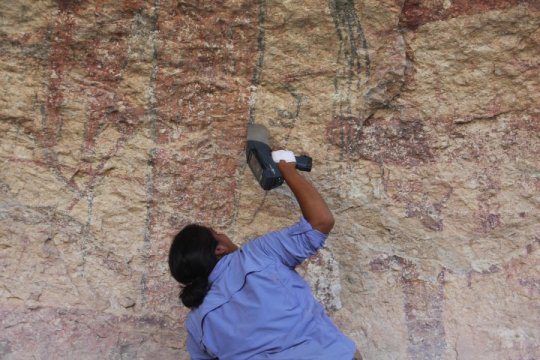[ad_1]
Prehistoric rock paintings are a source of fascination across the world. Aside from their beauty, there’s deep meaning in these strokes, which depict ancient rituals and important symbols. To learn more about these murals, researchers have historically resorted to sampling methods that are damaging to the artwork, contradicting the archaeological tenets of conservation. Today, scientists report use of “X-ray vision” to gain brand-new insights about the layers of paint in rock art in Texas without needless damage.
The researchers will present their results today at the American Chemical Society (ACS) Spring 2019 National Meeting & Exposition.
“In this particular work, we used a technique called portable X-ray fluorescence spectroscopy (pXRF), in which a handheld instrument can be carried to a site and used right there, on the spot,” says Karen Steelman, Ph.D., who led the study. “It gives you the elemental analysis of a specific material, and is the first step in figuring out how ancient artists used different materials to make their paintings.”
Steelman’s research focuses on the analysis of rock and cave art, particularly in the Lower Pecos Canyonlands in Texas. She and her colleagues at the Shumla Archaeological Research & Education Center have previously analyzed the composition of pigments at more than 10 sites in the region, but had been unable to see the bigger picture of how these pictographs were composed. Other pigment analysis methods, such as inductively coupled plasma mass spectrometry, require a sample of the rock art in question, which results in damage to the site, and field microscopes are unable to detect layers of paint in a complex mural.
For this particular study, Steelman and her colleagues visited the Rattlesnake Canyon Site along the Rio Grande, known for its array of pictographs. Using a 105-foot wide mural as their testing canvas, they used pXRF to measure 138 areas where the composition indicated overlapping pigments of red, black, white and yellow. In addition, measurements were taken at 90 locations of unpainted limestone, which provided insight into the makeup of the geological canvas.
Using the large amount of data collected from Rattlesnake Canyon, the team could determine a pattern to the layers of pigment, as well as their elemental makeup. The pXRF measurements revealed previously unseen layers of black pigment under layers of red, which were made with manganese and iron oxide, respectively. These complex layers of pigment indicated a level of sophistication seen in other Lower Pecos sites, which ethnographers have determined are a series of religious murals that revealed the complex nature of the hunter-gatherer society that occupied the region from 2500 BCE to 500 CE.
In addition to their findings on the composition of the pictographs, Steelman, along with fellow Shumla collaborators Victoria Roberts and Carolyn Boyd, Ph.D., discovered that the site appeared to contain gunshot damage. To confirm their suspicions, they again turned to pXRF to identify any trace elements that could have come from ammunition. “Unfortunately, we often see suspected bullet impacts at rock art sites,” Steelman says. “Most of this is older types of vandalism from the early 1900s, and we used the portable X-ray to determine what trace elements were present.” At the impact sites, pXRF revealed traces of lead, mercury and selenium, which were not present in the undamaged areas. There is a bright side to this discovery; finding damage at archaeologically significant sites is an opportunity to petition state and federal agencies for conservation funds to use for more extensive preservation measures, Steelman explains.
With over 350 known rock art sites in the Lower Pecos Canyonlands alone, Steelman and team plan to continue using pXRF to see the full picture of the tapestry of color and symbol woven throughout the region. Flooding along the Rio Grande is a major threat to what the researchers describe as “the oldest books in North America,” and they are on a mission to document and analyze as many sites as possible to preserve these stories for future generations.
Story Source:
Materials provided by American Chemical Society. Note: Content may be edited for style and length.
[ad_2]















